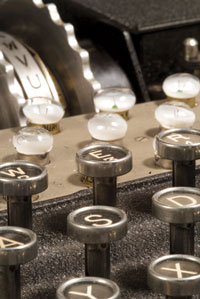WWII Enigma machine display to be revamped by MRU students
by Edward Osborne

Photo Courtesy of the Military Museums. Breaking the Enigma was one of the key inventions that helped the Allies win the Second World War. The machines were used to relay all the strategic information of Nazi Germany, and being able to read those communiqués forewarned the British of all manner of disaster.
Mount Royal students may soon be contributing to the Military Museums’ display of the historic Enigma machine. The code-breaking contraption that changed the course of the Second World War is on permanent loan to the Military Museums and first-year students in the Information design program at MRU have been tasked with creating a proposal for a revamped museum display that would put the machine in the forefront of the collection.
Breaking the Enigma was one of the key intelligence advantages that helped the Allies win the war. The machines were used to relay all the strategic information of Nazi Germany, and being able to read those communiqués forewarned the British of all manner of disaster. The original Enigma machine was made in the early 1920s by a calculator manufacturer. It used the same basic mechanic systems as a calculator of that era, with punch keys, lights and rotors to build a code rather than accomplish mathematics. Various versions were produced during the build- up to the Second World War including the Swiss K model, which is now on display in Calgary. This Calgary Enigma has a separate display panel and cover for increased secrecy, so that one person would input the coded message and another would receive the result. The reader had no idea what the original message had looked like, and the transmitter didn’t know the meaning of what he had decoded.
The Enigma is a symbol of military secrecy that extends well beyond its use in the Second World War. Even after the war, its compromise at the hands of the allies was kept secret. The Enigma is one of the key pieces of technology of our past. It was a device that pushed the boundaries of the time and laid the foundation for the future. Codes and code breakers were crucial during the war, when all radio communication was broadcast openly for lack of a closed communication system. You knew for a fact that the enemy would be listening in, so it was necessary that your messages were indecipherable to anyone but you and yours. The Germans adopted the Enigma as their national encryption device and distributed thousands of them to their air force, navy, and diplomatic corps.
The capture and breaking of the Enigma machine was a turning point in the war. It took vast resources; even when the Allies had their own machine to test German transmissions on, the variable starting position of the machine’s wheels meant that billions of permutations were possible. The only way the Germans could translate what they were receiving was by using codebooks where the date dictated a Reich- wide setting for the machine’s wheels. “Water-soluble ink meant that if you captured a submarine, you had better get down there to those codebooks fast,” said Bruce Connolley, assistant curator for the museum. If a German boat was at risk of capture, the codebooks could be rendered useless to the Allies by throwing the books overboard, or by using a well-placed pot of tea to soak their pages.
This difficulty forced the British to enlist code crackers to mathematically decipher the code. The machine they designed to calculate the permutations of code and probability of the German language was called the “bomber” and was a precursor to the computer. In fact, it was the first step towards the massive punch-card machines of the 1950s and the electronic revolution we are still in the midst of today.
MRU’s Information design students have been given an opportunity to assist with the presentation of the Enigma in Calgary. Capt. Bill Wilson of the Naval Museum in Calgary contacted Glenn Ruhl, chair of information design, about using students to design components of the display. The students’ proposal is still in the formative stages, but a completed version will be submitted to the museum before the end of November.
Ruhl described his students as full of “nervous excitement” over the possibility of an MRU-designed display being realized. “If (the museum) wants to take it to the next level that’s great,” he said. “Any number of things can be done with the proposal.”
The entire first-year class has been divided into five teams, each of which will be judged by the rest of the class before a final vision is assembled to be Mount Royal’s collaborative proposal. Leslie Blondhal is heading the signage and labeling group. “Trying to design something that is interesting and engaging to both children and seniors is proving a challenge,” she said. “Having a museum judge our work makes the assignment feel more relevant and interesting.”
Ian Templin is working with Blondhal’s group and envisions a display covering “everything from promotions and advertising outside the museum to minute details of colour schemes and typography.” The class will offer a gamut of options, from which the museum curators can pick and choose what will be implemented into the exhibit. Connolley is looking forward to seeing what the students produce. He envisions a multimedia display with options for children groups or more serious users. The display would feature a beginner-, intermediate- and advanced- level analysis of the enigma and its significance.





Did the display get reworked? I’m working on a tour of an Enigma demonstration and workshops on codebreaking. Would the museum be interested in participating?